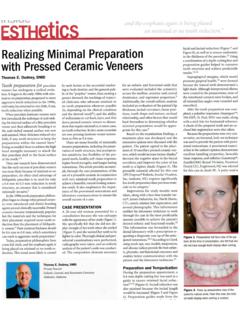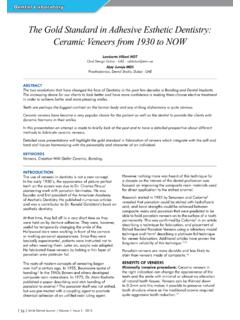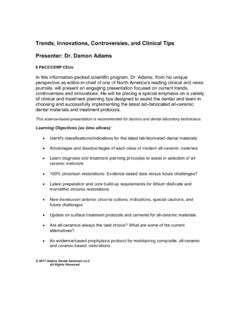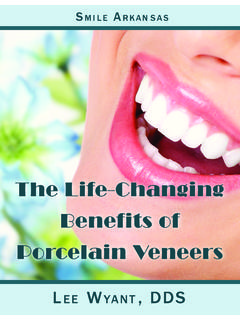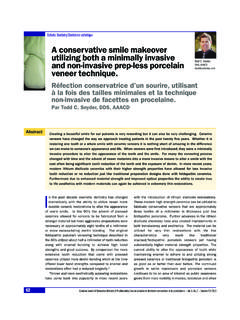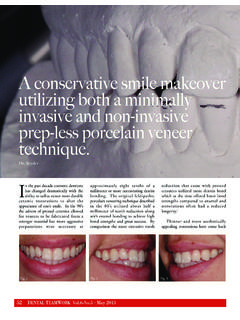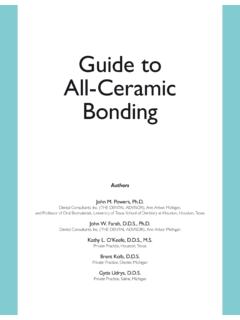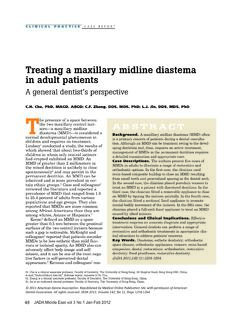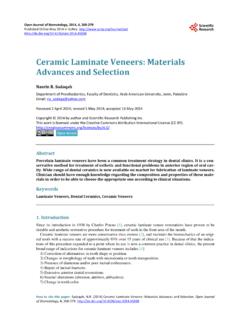Transcription of 48 Col Winter 2003 MODERN CERAMIC VENEER ALTERNATIVES
1 48 Collaborative Techniques Winter 2003 AdvertisementMODERN CERAMICVENEER ALTERNATIVESM ichael C. DiTolla, DDS, FAGDD irector of Clinical Education and Research, Glidewell LaboratoriesPorcelain veneers have becomean accepted treatment modal-ity for the MODERN dentalpractitioner to restore missing toothstructure and to enhance direct composite veneersremain a viable treatment option aswell, most dentists routinely utilizeceramic veneers due to the increasedstrength and longevity. These alsoenable the restorations to be builtslowly by a CERAMIC artist while thepatient wears provisional restora-tions. The evolution of the prepara-tion and bonding techniques thathave occurred in the last 15 yearshave increased the success, predict-ability, and demand for theseservices. Most recently, a network tele-vision show Extreme Makeover has thrust aesthetic dentistry intothe limelight as never first CERAMIC veneers werefabricated from feldspathic porce-lain.
2 With the launch of IPS Empress15 years ago, pressed ceramicsbecame the most popular techniquefor fabricating veneers. In our labora-tory today, 86% of porcelain veneersare fabricated from pressed ceramicand 14% are fabricated from felds-pathic. However, there are certainlytimes when feldspathic ceramicrestorations can be preferable topressed CERAMIC restorations. Thisarticle examines the two techniquesand discusses a rationale for choos-ing one over the OFPRESSED CERAMIC : Wear compatibility Increased translucency Ability to wax-up final con-tours prior to pressing Stronger than feldspathic (IPSE mpress 120 MPa compared to60 MPa to110 MPa feldspathic) More consistent results forthe average ceramistADVANTAGES OFFELDSPATHIC CERAMIC : Ability to mask out darkerpreps Less tooth structure removal(.3 mm to .5 mm vs .6 mm mm) More 3D appearance in thin-ner areas Ability to use same ceramicas in adjacent PFMs Ability to place different opac-ity levels within the restorationRECOMMENDATIONSFOR pressed CERAMICSELECTION: When significant malpositionexists in arch When significant increase intooth length is desired When strength is of utmostimportanceRECOMMENDATIONSFOR FELDSPATHICCERAMIC SELECTION: When minimal preparation isdesired due to patient con-cerns or minimal changes insize, shape, and shade Diastema closures when shadeis not altered significantly Teeth with minimal malposi-tions within the arch When adjacent teeth will havePFM restorations placedCONCLUSION:While either fabrication techniquecan be a viable solution for mostceramic VENEER cases, there are dis-tinct advantages and disadvantagesto both techniques.
3 The key toaesthetic success remains largelyin the artistic capabilities of theceramist. Materials and techniqueswork differently in different hands,therefore, it is imperative to builda relationship with a laboratorythat suits your needs both func-tionally and aesthetically. Consultwith your laboratory regarding thematerials they prefer on certaincases to achieve the most natural-looking result. Sending preopera-tive, preparation, and provisionalphotographs and study models asguideposts for your laboratory willprovide the best chances of creat-ing the smile envisioned by youand your patient. 4141 MacArthur BlvdNewport Beach, CA 92660800-854-7256 Fax: 800-599-9564 porcelain is built-up on a refractory model using internalmodifiers, body, and enamel powders. FIGURE patient presented withmultiple diastemata and requesteda brighter 6. After firing, the veneers canbe further modified with stain and thenglazed for final aesthetic minimal tooth prepara-tion, the feldspathic veneers improvedaesthetics and IPS Empress restorationis fabricated by waxing the VENEER onthe master die, investing, and pressinginto patient presented withworn incisal edges and desired 2.
4 After divesting, the veneerscan be stained or cut back and layeredto accentuate the incisal is a typical IPS Empressveneer smile enhancement that createsa natural-looking Glidewell 12/5/03 4:30 PM Page 48

